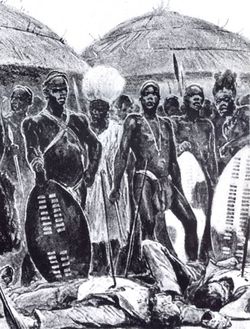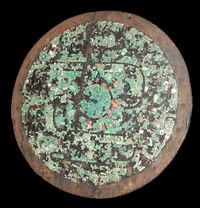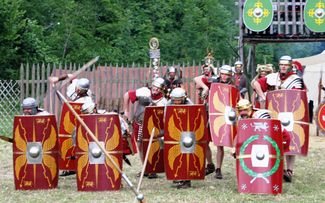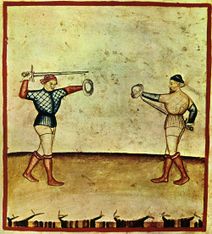Shield



A shield is a type of personal armor, meant to intercept attacks, either by stopping projectiles such as arrows or by glancing a blow to the side of the shield-user. Shields vary greatly in size, ranging from large shields that protect the user's entire body to small shields that are mostly for use in hand-to-hand combat. Shields also vary a great deal in thickness; whereas some shields were made of thick wooden planking, to protect soldiers from spears and crossbow bolts, other shields were thinner and designed mainly for glancing blows away (such as a sword blow). In prehistory, shields were made of wood, animal hide, or wicker. In antiquity and in the Middle Ages, shields were used by footsoldiers and mounted soldiers. Even after the invention of gunpowder and firearms, shields continued to be used. In the 18th century, Scottish clans continued to use small shields, and in the 19th century, some non-industrialized peoples continued to use shields (e.g. Zulu warriors). In the 20th and 21st century, shields are used by military and police units that specialize in anti-terrorist action, hostage rescue, and siege-breaching. The term often refers to a device that is held in the hand/arm, as opposed to an armoured suit or a bullet proof vest.
Contents |
Prehistory and antiquity

The oldest form of shield was a protection device used to block attacks by hand weapons, such as swords, axes and maces or missiles like spears and arrows. Shields have varied greatly in construction over time and place. Sometimes shields were made of metal, but wood or animal hide construction was much more common; wicker and even turtle shells have been used. Many surviving examples of metal shields are generally felt to be ceremonial rather than practical, for example the Yetholm-type shields of the Bronze Age or the Iron Age Battersea shield. The shield was used to make the Greek Phalanx formation.
Size and weight varied greatly. Lightly armored warriors relying on speed and surprise would generally carry light shields that were either small or thin. Heavy troops might be equipped with large heavy shields that could protect most of the body. Many had a strap called a guige that allowed it to be slung over the user's back when not in use or on horseback. During the 14th-13th century BC, the Sards or Shardana, working as mercenaries for the Egyptian pharaoh Ramses II, utilized either large or small round shields against the Hittites. The Mycenaean Greeks used two types of shields: the "figure eight" or "fiddle" shield, and a rectangular type, the "tower" shield, rounded on the top. They were made of wood and leather, and were of such a large size that a warrior could hide completely behind his shield. The Ancient Greek hoplites used a round, bowl-shaped wooden shield called an aspis. Examples of German wooden shields c350 BC - 500 AD survive from weapons sacrifices in Danish bogs.
The heavily armored Roman legionaries carried large shields (scuta) that could provide far more protection, but made swift movement a little more difficult. The scutum originally had an oval shape, but gradually the curved tops and sides were cut to produce the familiar rectangular shape most commonly seen in the early Imperial legions. Famously, the Romans used their shields to create a tortoise-like formation called a testudo in which entire groups of soldiers would be enclosed in an armoured box to provide protection against missiles. Many ancient shield designs featured incuts of one sort of another. This was done to accommodate the shaft of a spear, thus facilitating tactics requiring the soldiers to stand close together forming a wall of shields.

Middle Ages
In the early European Middle Ages, kite shields were commonly used; these were rounded at the top and tapered at the bottom. They were easily used on horseback and allowed easier leg movement when dismounted. As personal body armour improved, knight's shields became smaller, leading to the familiar heater shield style. Both kite and heater style shields were made of several layers of laminated wood, with a gentle curve in cross section. The heater style inspired the shape of the symbolic heraldic shield that is still used today. Eventually, specialised shapes were developed such as the bouche — which had a lance rest cut into the upper corner of the lance side, to help guide it in combat or tournament.Free standing shields called pavises, which were propped up on stands, were used by medieval crossbowmen who needed protection while reloading.
In time, some armoured foot knights gave up shields entirely in favour of mobility and two-handed weapons. Other knights and common soldiers adopted the buckler (origin of the term "swashbuckler"[1]). The buckler is a small round shield, typically between 8 and 16 inches (20-40 centimeters) in diameter. The buckler was one of very few types of shield that were usually made of metal. Small and light, the buckler was easily carried by being hung from a belt; it gave little protection from missiles and was reserved for hand-to-hand combat. The buckler continued in use well into the 16th Century.
In Italy, the targa, parma and rotella were utilized by common people, fencers and even knights. The development of plate armour made shields less and less common as plate armour eliminated the need for a shield. Lightly armoured troops continued to use shields after men-at-arms and knights ceased to use them. Shields continued in use even after gunpowder powered weapons made them essentially obsolete on the battlefield. In the 18th Century, the Scottish clans used a small, round shield called a targe that was partially effective against the firearms of the time although it was arguably more often used against British infantry bayonets and cavalry swords in close-in fighting.
In the 19th Century, non-industrial cultures with little access to guns were still using shields. Zulu warriors carried large lightweight shields made from a single ox hide supported by a wooden spine, these were called Ishlangu.[2] This was used in combination with a short spear (assegai) and/or club. Although the size of shield would vary between personal preference and role, most were very thin compared to common belief (a misconception aided by the depiction of heavy shields in popular films). When used in fighting, shields were best to take advantage of causing glancing blows. By deflecting a sword blow to the side, rather than blocking it head on, the attacker may become open to a counterattack with a fast weapon. This method allowed the shield to be lighter and easily wielded, while reducing the amount of energy and risk of injury for the wielder.
Modern era
Law enforcement shields
,_Special_Boat_Team_22_conducts_training_16_AUG_09.jpg)
Shields for protection from armed attack are still used by many police forces around the world. These modern shields are usually intended for two broadly distinct purposes. The first type, riot shields, are used for riot control and can be made from metal or synthetics, such as Lexan or Mylar. These typically offer protection from relatively large and low velocity projectiles, such as rocks and bottles, as well as blows from fists or clubs. Synthetic riot shields are normally transparent, allowing full use of the shield without obstructing vision. Similarly, metal riot shields often have a small window at eye level for this purpose. These riot shields are most commonly used to block and push back crowds when the users stand in a "wall" to block protesters, and to protect against shrapnel, projectiles, molotov cocktails, and during hand-to-hand combat.
The second type of modern police shield is the bullet-resistant tactical shield. These shields are typically manufactured from advanced synthetics such as kevlar and are designed to be bulletproof, or at least bullet resistant. Tactical shields often have a firing port so that the officer holding the shield can fire a weapon while being protected by the shield, and they often have a bulletproof glass viewing port. They are typically employed by specialist police, such as SWAT teams in high risk entry and siege scenarios, such as hostage rescue and breaching gang compounds, as well as in antiterrorism operations. Tactical shields often have a large signs stating "POLICE" (or the name of a force, such as "US MARSHALS") to indicate that the user is a law enforcement officer.
Gun shields
With the widespread use of machine guns in WW I and in subsequent conflicts, battlegrounds were swept with automatic weapons fire. While soldiers who are in foxholes or trenches are protected from this fire, soldiers who are manning mounted machine guns were vulnerable to being hit. Since WW I, there have been a variety of attempts to install armored gun shields on tripod-mounted machine guns or vehicle-mounted weapons to protect machine gunners. Transportation devices with mounted guns that may have gun shields to protect the gunner include jeeps, Humvees, armored cars, and boats.
Non-martial applications
Many non-martial devices also employ shielding of a kind--not usually a single device worn on an arm but various protective plates or other insulation positioned where needed. Space craft have heat shields to ensure a safe re-entry. Electronics uses shielding to reduce electrical noise and crosstalk between signals. Better-quality patch cables used in audio and electronic music have shielding to reduce interference and noise. People and systems that must work in the presence of ionizing radiation (X-rays) such as dentists, hospital technicians, and patients undergoing X-rays are protected with lead shielding clothing.
A "shield" is also a design term used to describe emblems that resemble a heraldic shield. Movie studio Warner Bros. uses a shield emblazoned with WB as its logo. The Looney Tunes cartoons, released through Warner Bros., open with the WB shield zooming through concentric circles.
Fictional use
Science fiction writers have imagined many futuristic protections they often call "shields," usually using force fields. These include personal shields, as in the Dune series, or larger ones for spacecraft as in Star Trek. In the Star Trek movies and TV shows, the deployment of "force field"-type shields is used to protect the spaceship from hostile enemy fire, usually in the form of beam weapons. Due to the immense energy requirements of these shields, the ship commander must be judicious in deciding when to use the shields; excessive use of the shields can deplete the ship's energy stores and make the use of other systems (e.g., beam weapons or thrusters) infeasible.

See also
- Buckler
- Heater shield
- Kite shield
- Scutum
References
- Bibliography
- Drummond, James. "Notes on Ancient Shields and Highland Targets" Archaeologica Scotica Vol 5 (1890)
- Schulze, André(Hrsg.): Mittelalterliche Kampfesweisen. Band 2: Kriegshammer, Schild und Kolben. - Mainz am Rhein. : Zabern, 2007. - ISBN 3-8053-3736-1
- Notes
- ↑ "The Sussex Rapier School". Hadesign.co.uk. http://www.hadesign.co.uk/SRS/html/buckler.htm. Retrieved 2008-12-26.
- ↑ "Zulu Shield (Longo)". Rrtraders.com. http://www.rrtraders.com/Shields/zuluw.htm. Retrieved 2008-12-26.
External links
- Myarmoury.com, The Shield: An Abridged History of its Use and Development.
- Baronage.co.uk, The Shape of the Shield in heraldry.
- Era.anthropology.ac.uk, Shields: History and Terminology, Anthropological Analysis.
- Hadesign.co.uk, The Buckler, The Sussex Rapier School.
- Classical Greek Shield Patterns.
.jpg)